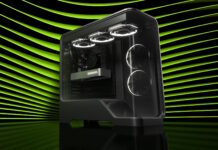Many were astounded by how well GeForce 9600GT performed in the first reviews. Even though the number of shader processors were reduced to 64, it was breathing down the neck of the much better equipped 8800GT. Many reviews have used factory-overclocked cards, simply because many partners decided to launch overclocked cards, instead of going with NVIDIA’s reference of 650MHz. However there have been some oddities, and in some cases, GeForce 9600GT has performed extremely well, even at the reference frequency.
In other cases, people have had to downclock the card to make it work. Some partners have launched quite heavily overclocked cards and for natural reasons these were unstable to a higher degree, but now to a higher degree than normal. Downclocking the cards have been the only solution, which is a pity when you’ve paid for an overclocked card.
This called for further investigation and the people over at techPowerUp! noticed a discrepancy between the frequency reported by the driver and the clock generator. Most tools will read the frequency from the driver, but the RivaTuner monitor reads directly from the clock generator. However, the monitoring reads the information incorrectly. It multiplies by 27 instead of 25.
The problem is that the only physical crystal on the card is 27MHz, but the driver use a crystal frequency of 25MHz to calculate the GPU frequency. This doesn’t quite add up. To test this in practice they turned to the multitexture fillrate test in 3DMark 06 and compared how much better 9600GT performed when raising the PCIe frequency. Increments of 5MHz clearly showed that performance scaled linearly to that. Similar tests with 8800GT show no performance improvement what so ever.
It seems like NVIDIA has designed the GPU so that that it takes the PCIe frequency and divides by four to get the crystal frequency. This means that if you overclock the PCIe bus you also overclock the GPU. But the things is, the drivers will still report the stock frequency when you overclock the PCIe bus. E.g. if you raise the PCIe bus from 100 to 104MHz the GPU will jump up to 676MHz, from 650MHz, but the driver, and all tools reading from the driver (GPU-Z, RivaTuner and so forth), will still report 650MHz.
This is quite a nifty feature, and something NVIDIA should be proud of. The problem is that NVIDIA has been hiding it from reviewers and editors. The card may simply have been running overclocked without people knowing, not even the author of the article. Quite poor execution by NVIDIA.
If we also take into consideration that some motherboards sport an automagical overclock of the PCIe bus, for example LinkBoost, it could become a stability issue. A 25MHz overclock of the PCIe bus would make most 9600GT cards unstable due to the much higher GPU frequency.
We really recommend you to read through the article over at techPowerUp!.


















